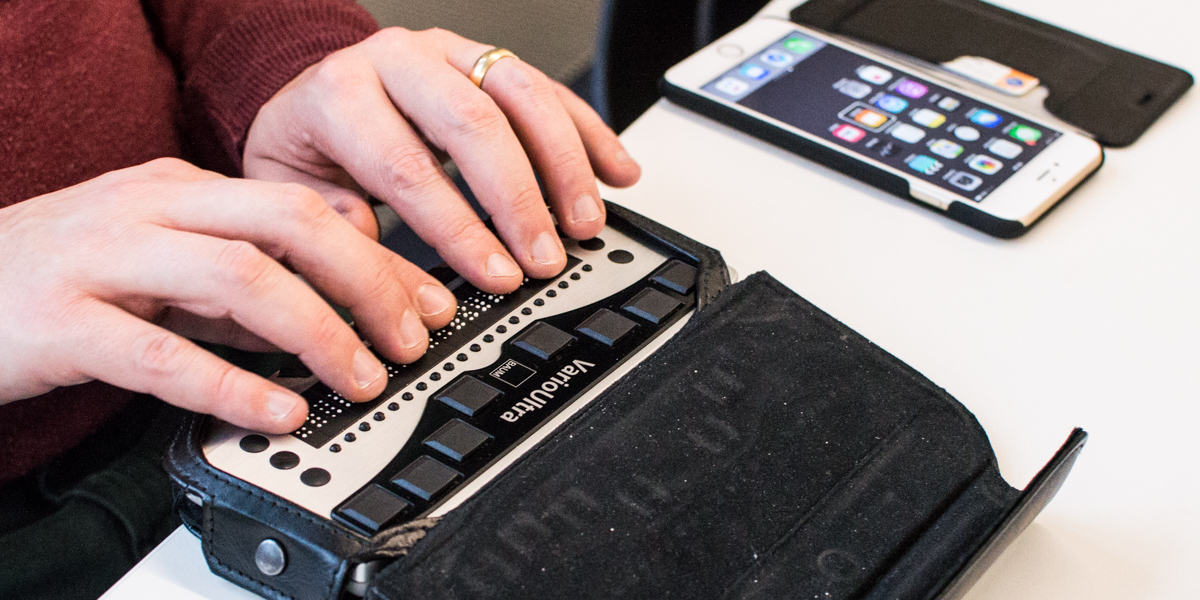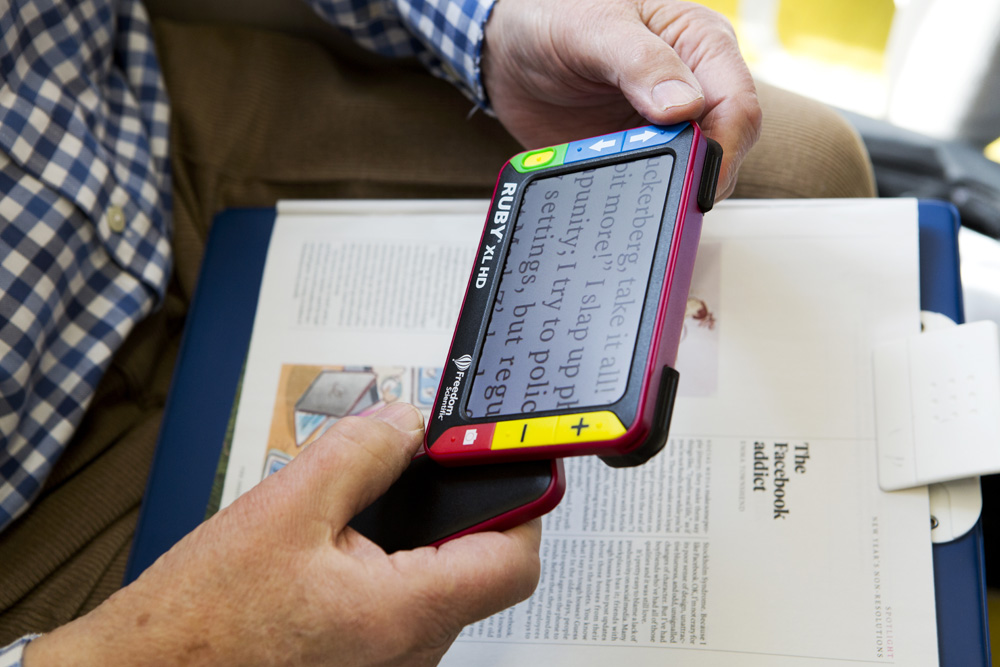Wearable Technology for Low Vision: A Game-Changer in Accessibility
Wearable Technology for Low Vision: A Game-Changer in Accessibility
Blog Article
Discover Innovative Tools Developed for the Visually Damaged
The development of cutting-edge tools for the aesthetically damaged represents a significant advancement in availability and self-reliance. Technologies such as wise glasses with AI capacities and mobile applications developed to offer auditory summaries are improving everyday experiences for users. Furthermore, wearable devices that employ haptic responses boost ecological understanding, while modern Braille technologies supply brand-new methods to engage with message. As these tools proceed to advance, their effect on the lives of those with visual disabilities increases essential concerns concerning the future of inclusivity and autonomy in various aspects of life. What lies in advance in this technological landscape?
Smart Glasses for Navigating

Smart glasses made for navigating are revolutionizing the way aesthetically impaired people engage with their environment. These advanced gadgets make use of a mix of electronic camera technology, man-made knowledge, and acoustic comments to supply real-time info concerning surroundings. By employing obstacle detection systems, clever glasses can inform customers to prospective threats, enabling much safer wheelchair in both unknown and acquainted settings.
The assimilation of GPS innovation additionally boosts navigating capacities, allowing customers to get acoustic directions as they move. This hands-free strategy not just fosters independence however likewise encourages aesthetically damaged people to browse urban landscapes with boosted self-confidence. Furthermore, numerous smart glasses are equipped with attributes that determine spots and road indications, offering contextual information that boosts the individual experience.
Furthermore, the development of these devices is continually progressing, with business functioning to enhance the accuracy of item recognition and expand the variety of navigational functions. As smart glasses come to be much more accessible and budget friendly, they hold the potential to considerably change life for aesthetically impaired individuals. Eventually, these cutting-edge devices represent a crucial action towards inclusivity, offering boosted mobility and a higher sense of autonomy for individuals browsing the globe around them.

Mobile Apps for Daily Living
How can mobile applications enhance the day-to-day lives of aesthetically damaged people? Mobile apps are reinventing the way visually damaged individuals navigate their settings, handle day-to-day tasks, and gain access to info. These applications offer important assistance with various functionalities, fostering freedom and boosting high quality of life.
Several cutting-edge mobile apps are made especially for everyday living. As an example, applications like Be My Eyes connect aesthetically impaired customers with sighted volunteers through video phone calls, permitting them to get real-time support with jobs such as checking out labels or navigating unfamiliar spaces. Similarly, Seeing AI, developed by Microsoft, makes use of man-made intelligence to define surroundings, reviewed text, and determine things, successfully changing a smart device into an effective tool for everyday help.
Furthermore, navigating apps customized for the visually impaired, such as Aira and BlindSquare, use audio-based instructions and environmental information, allowing users to traverse their environments safely and confidently. Beyond navigation and instant help, mobile applications also sustain company and task administration, with attributes that aid users establish pointers, develop order of business, and track appointments. In summary, mobile applications serve as vital sources, empowering visually damaged people to lead even more independent and meeting lives.
Wearable Technologies for Assistance
Empowerment with innovation is increasingly apparent in the half moon reading glasses world of wearable tools created to help aesthetically damaged people. These ingenious devices incorporate flawlessly into life, enhancing navigation and giving vital comments to individuals. For example, wise glasses furnished with electronic cameras can read and recognize faces message aloud, enabling users to engage more with confidence in professional and social settings.
An additional significant development is the use of haptic feedback systems in wearable tools. These systems use vibrations or various other responsive signals to share info about the customer's atmosphere, such as obstacles or adjustments in surface, improving movement and safety and security. Wearable modern technologies also consist of wristbands that link to smartphones, signaling customers to alerts with refined vibrations, hence improving connectivity without reliance on visual hints.
As these technologies proceed to evolve, they are not just improving self-reliance for aesthetically damaged individuals yet also cultivating a higher feeling of addition in society. By connecting the gap in between difficulties faced in day-to-day living and the capacity for freedom, wearable technologies function as critical devices in the quest for equal rights and empowerment for those with aesthetic disabilities.
Sound Summary Tools
Sound description tools play a vital role in improving availability for visually impaired individuals, providing them with the capacity to involve with visual media. Braille displays and notetakers. These devices supply narrated descriptions of essential aesthetic components in films, television programs, and live efficiencies, guaranteeing that individuals can totally understand the context and feelings conveyed with visuals
Sound summary can be integrated into various platforms, including streaming solutions, movie theater testings, and live cinema. Many prominent streaming services currently consist of audio description as an access feature, allowing visitors to select it conveniently. Along with conventional media, specialized apps also exist, offering audio descriptions for art exhibits, museums, and other social occasions.
The efficiency of audio summary depends upon the ability of the storytellers, that need to share aesthetic details succinctly without diminishing the original audio. Innovations in this field are likewise leading the way for even more tailored experiences, where users can change the degree of information and pacing according to their choices.
Braille Innovations and Gadgets
Braille tools and innovations have dramatically transformed the way visually impaired individuals communicate with text and info. Modern improvements have actually led to the growth of functional devices that boost proficiency and freedom amongst customers.
Moreover, mobile Braille notetakers combine conventional Braille input with modern functionalities, helping with note-taking, scheduling, and file modifying on the go. Speech-to-text devices for low vision. These portable tools usually include text-to-speech abilities, connecting the gap between Braille and acoustic info
In addition, innovative Braille printers have actually arised, enabling users to visually impaired products generate Braille tags, files, and educational materials effectively. This accessibility promotes better engagement in specialist and instructional atmospheres, ultimately advertising inclusivity.
Moreover, research right into wise Braille technologies remains to broaden. Tools that incorporate artificial knowledge are being explored to supply real-time navigation assistance and contextual details, boosting the individual experience in varied settings. On the whole, these developments mirror a commitment to empowering visually impaired people through innovation, ensuring they can quickly access and involve with the globe around them.

Final Thought
The innovation of cutting-edge devices for the aesthetically damaged substantially improves self-reliance and lifestyle. Smart glasses, mobile applications, wearable modern technologies, audio summary devices, and Braille technologies collectively encourage people by supplying necessary navigation support, ecological understanding, and improved analysis experiences. These innovations not only foster greater incorporation however also promote freedom in everyday activities, inevitably adding to a more accessible and fair culture for visually damaged individuals. Proceeded advancement in this field holds assurance for additional enhancements.
As clever glasses come to be much more cost effective and available, they hold the prospective to significantly change everyday life for visually damaged users. Mobile applications are reinventing the method visually damaged users navigate their environments, handle daily jobs, and accessibility info. Apps like Be My Eyes link visually damaged users with sighted volunteers using video calls, permitting them to get real-time assistance with jobs fun glasses frames such as reading labels or browsing strange spaces.Additionally, navigation applications customized for the aesthetically damaged, such as Aira and BlindSquare, offer audio-based instructions and ecological details, allowing customers to traverse their surroundings securely and confidently.The improvement of cutting-edge tools for the visually impaired substantially enhances self-reliance and quality of life.
Report this page